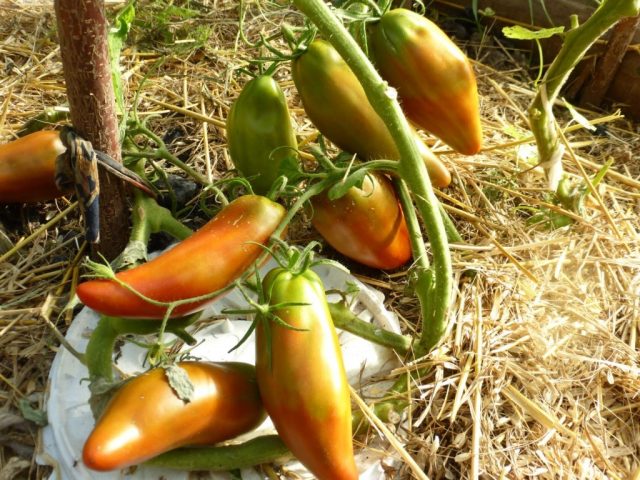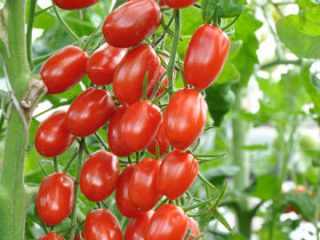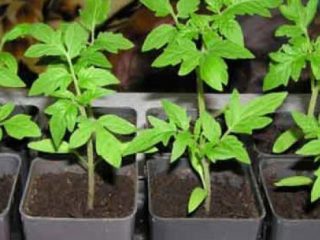Content
The Cuban pepper tomato is readily cultivated in almost all regions of Russia. This variety is intended for closed ground and shows good results only when grown in a greenhouse. Its fruits are sweet and fleshy, have excellent commercial qualities, are ideal for salads, and can be used in the preparation of tomato juice and paste.

Other names of the variety are Cuban pepper, Cuban black, Black pepper
History of selection
The Cuban pepper tomato variety was developed by an unknown author. No one was able to clarify the time of selection of the variety either. Presumably the species was the result of the work of domestic specialists.
Description of the Cuban pepper black tomato
Brown tomato Cuban pepper, description, photos and reviews of which are presented below, is an indeterminate tall variety. Throughout the growing season, the bushes constantly grow and can reach a height of more than two meters.Because of this, they need to be attached to trellises and formed into one or two stems. Tomato leaf blades are medium in size, dark green in color, and are present on the bushes in fairly large quantities, which is why they are periodically thinned out.
The fruits of the Cuban pepper tomato are large, their weight varies from 200 to 300 g. The shape is elongated and elongated, reminiscent of a bell pepper. The color of a tomato when ripe is dark brown or burgundy.
The tomato pulp is fleshy, aromatic and juicy, with a small amount of seeds. It is hidden under a rather strong, but at the same time delicate, smooth skin. The taste qualities of the variety are highly rated. The tomato is sweet and tasty.

Cuban pepper is grown particularly for food.
Characteristics of the Cuban pepper tomato
Cuban pepper is characterized by high yields and excellent commercial qualities that last for a long time. Thanks to their dense structure, tomatoes do not crack and, if storage rules are followed, remain beautiful even several weeks after harvesting. The variety has good resistance to extreme conditions such as drought, but does not tolerate cold. Has high resistance to infectious diseases.
Cuban pepper tomato yield
The variety is a high-yielding variety.But in order to achieve maximum results, it is important to organize proper care for plantings, as well as follow the rules of agricultural cultivation. The number of fruits is greatly influenced by the quality of the soil and temperature conditions. Thermometer readings from +18 to +25 °C are considered optimal.
Resistance to diseases and pests
Cuban pepper is characterized by good resistance to major tomato diseases, as well as harmful insects. But in order to protect the bushes from troubles, experienced vegetable growers recommend regularly carrying out preventive treatments of the plantings.
Methods of application
Cuban pepper fruits are intended for fresh consumption. They are usually used for cutting into salads and preparing vegetable snacks; they are often left for storage, since they tend not to spoil for a long time. The fruits are not suitable for canning as a whole due to their large size. Some housewives use tomatoes for juice or prepare sauces and pastes from it.
Advantages and disadvantages
The Cuban pepper tomato (black) has a number of advantages, but the variety also has its own disadvantages. Before planting this tomato variety, it is advisable to familiarize yourself with all the nuances that the technology of growing it involves.

Cuban pepper is recommended for cultivation indoors
Advantages:
- excellent commercial quality;
- good yield;
- excellent taste;
- keeping quality;
- high resistance to drought;
- good immunity.
Flaws:
- need for shaping and gartering;
- demands on soil fertility.
Features of planting and care
Since the Cuban pepper tomato variety is late, gardeners begin to plant seeds for seedlings already in January, but it is allowed to do this until April. Before sowing, you need to prepare a container and planting material, for which you need to treat them with a weak solution of potassium permanganate. Next, pour fertile substrate into the boxes, plant the seeds, burying them 1-1.5 cm into the soil, sprinkle with water from a spray bottle and cover with film.
As soon as shoots appear on the surface of the soil, the shelter must be removed and the temperature in the room reduced to +22 °C. As the seedlings develop, they should be periodically moistened with warm and settled water, a week before picking, carry out the first feeding, then plant the sprouts in separate cups and feed again a week later.
When seven leaves grow on the bushes, it is time to plant them in a permanent place. The soil in the greenhouse where the Cuban pepper tomato will grow should be fertile, light, fertilized with humus, and well drained. After replanting the beds, it is recommended to moisten and then provide proper care for the plants:
- Watering. Tomatoes are moistened regularly, as soon as a dry crust forms on the surface of the soil.
- Mulching. Cuban pepper responds well to mulch in the form of wood chips or sawdust. A layer of them protects the roots of the plant from temperature changes, drying out of the soil, and prevents the growth of weeds.
- Formation. The variety requires gartering to reliable supports, which is done as the bushes grow. Cuban pepper tomatoes are usually molded into two stems.All shoots are removed from the bushes weekly.
- Trimming. Periodically, leaf plates are removed from the plant to block light from reaching the fruit.
- Fertilizer. The variety needs frequent feeding with minerals and organic matter. They begin three weeks after planting and are repeated every 14 days.

The Cuban pepper tomato is considered not a particularly demanding variety.
Pest and disease control
Although the Cuban pepper tomato has a proven track record of being resistant to diseases and pests, it can still suffer from some ailments at times. From time to time, bushes should be carefully inspected for signs of disease or insect attack.
If problems are detected, it is recommended to treat all tomato beds as soon as possible: for diseases - with fungicides, for insects - with insecticides. As a preventive measure, folk remedies in the form of garlic infusion or neem oil can be used from time to time.
Conclusion
The Cuban pepper tomato is a variety that deserves the attention of vegetable growers. It is distinguished by its excellent taste and unusual appearance; if the rules of agricultural technology are observed, it will please you with a rich harvest until the fall. Excellent for growing in a greenhouse, it has strong immunity, is most often used fresh, but is sometimes processed.
Reviews from gardeners about the Cuban pepper tomato








